Long White Gypsy uses affiliate links and is a member of the Amazon Services LLC Associates Program. If you make a purchase using one of these links, I may receive a small commission at no extra cost to you. See my Privacy Policy for more information.
**I lost many of my photos from the section up to Auckland. Unfortunately I have lost many of the photos I took from this day on Te Araroa.**
In the morning when I woke up, I was very excited to get going and to be properly back on trail.
Despite my best efforts, it had been a late night. My younger roommates in my hostel room were up until 11.30pm playing Monopoly. I eventually rolled out of bed in a dazed stupor and asked them to stop.
It was nearly 7.30am by the time I got out of bed. I packed up most of my pack and showered, then sat in the kitchen area enjoying a leisurely breakfast while I waited for the proprietor to open the office so I could pay for my final night.
Austin was already there with a kiwi girl named Kristy. I was surprised to hear that she was travelling up to Utea Park that day and was aiming to start Te Araroa from Cape Reinga the following day. I was even more surprised to hear she recognised me from YouTube.
I sat with her and we talked about gear for a long time, whilst Austin worked on shaving some more gear from his already ridiculously light pack. When he was done, his pack was almost empty. Nothing more than a daypack with a few bits of overnight gear. Crazy.
I saw he was trying to get rid of his warm jacket, so (just for fun) I asked what he would do when it gets cold. He said he’s used to being cold, and that he thought he could handle it.
 Austin & Thomas’ tiny backpacks after their severe shakedowns.
Austin & Thomas’ tiny backpacks after their severe shakedowns.
My mind wandered back to the massive storm that had passed through the previous night and I chuckled. I tried to explain that NZ is an island in the Southern Pacific ocean, and that as a result the weather can change very quickly, but he was having none of it.
It occurred to me that when you’re used to hiking 60 kilometres or more per day, perhaps things like a change of weather aren’t as much of an issue? Perhaps you just rely on outrunning storms and bad weather, or making it to the next place with a roof that you can spend the night warm and dry.
I also asked Austin what his plan was for emergency rations on the South Island. He looked at me askance, and then said:
“What do you mean?”
I proceeded to explain that it’s very common for people to get snowed or rained in at the huts on the South Island for days on end.
“Even in summer?” he asked.
“Even in summer,” I replied.
“Oh well. If it snows at a hut and it looks like we might get stuck… I guess we’ll just hike out.”
I had to take a very deep breath before replying. I explained that it might not be possible to hike out, to which he responded that he was used to hiking in the Sierra Nevada in knee deep snow. Respectfully, he could just hike out.
“That’s all very well, but when visibility is low and you can’t see the trail and there are no trail markers and the rivers are all in flood… what’s your strategy in that scenario?”
He stayed quiet. We eventually parted with my comment that at least he’d have something to think about for the few weeks before they get to the South Island. I hoped he did think about it.
Victoria arrived soon after, and I was able to pay up and get out quick. I made my way to the post office with a box full of gear I was ready to send home. I’d shaved a bunch of gear from my pack weight as well, with the help of Haley in Kaitaia and a stern talking-to or two from myself.
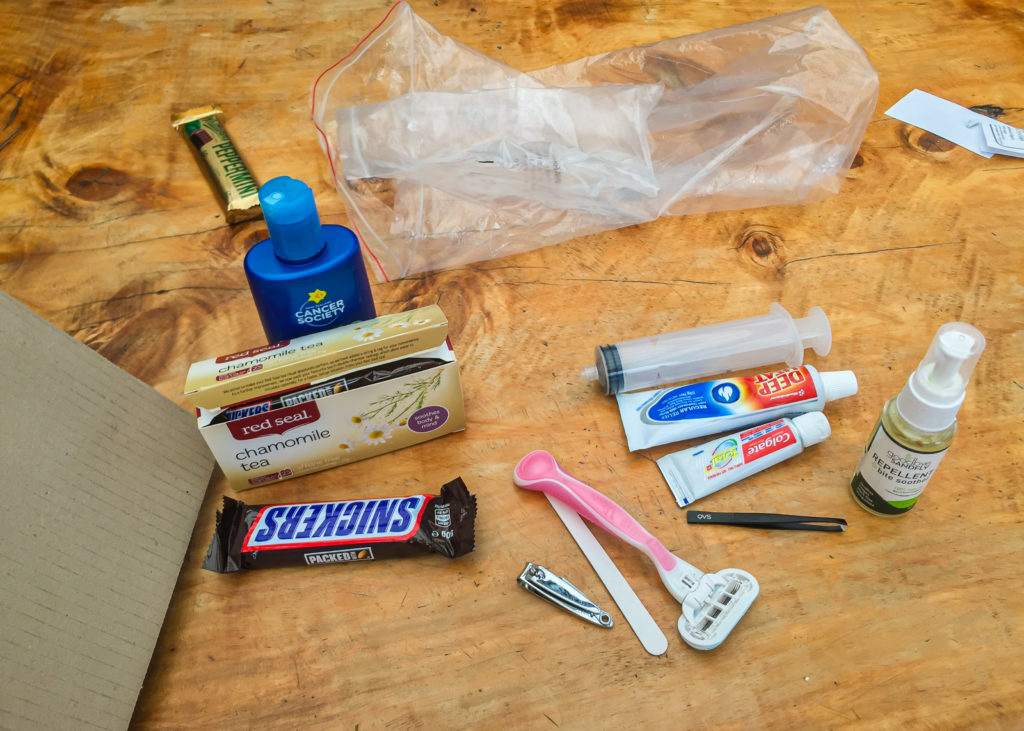 Some of the smaller gear items I decided to ditch from my pack in Kerikeri.
Some of the smaller gear items I decided to ditch from my pack in Kerikeri.
I noticed that on the way to the Post Office there were lots of tree branches down and debris from the storm last evening. I spared a thought once again for those who were still outside on the trail last night.
I couldn’t post my parcel until 9am when the post office was open. I arrived just before and saw that Julia was already there waiting for me. It was such a nice treat to see her again!
Once I’d posted the box of extra gear back home, I also posted another ahead to the Whananaki Holiday Park where I would (hopefully) collect it in a few days’ time.
Finally, Julia and I were on our way back to the Stone Store. Along the way we caught up about our adventures of the past few days, and specifically Julia filled me in on her adventures through the first of the forests and her exit from the trail.
She had made it through Raetea forest in one day, taking her 8 hours to get from one side to the other. She let me know that it wasn’t too bad, but it was steep and muddy.
The campsite on the other side of the mountain (I will have to check with her what it is called and update this later) was really nice and there were a lot of people there. This was where Julia and the rest of her party had been met by the local who had told them about the bad weather coming.
Most of the party pushed on to the Mangamuka Dairy the next day, at which point they all had another conversation about what the best way forward was. Some decided to stay the night in a small room just off the main road in Mangamuka. Julia opted instead to hitchhike to Kerikeri. She couldn’t see the point of hiking through a storm, and seeing that Mangamuka isn’t a great place to spend two or three days waiting it out thought it would be better to skip a small section of the trail.
She eventually managed to score a cabin at the same Holiday Park I’d visited a couple of days before, for a grand total of $35 … and ended up having it all to herself!
When she had finished I filled her in on mine, Haley’s and John’s whereabouts. By the time I had finished we were almost at the Stone Store.
This time, we took the same track up and over the grassy hill that I had taken the previous day, but this time instead of continuing on the track towards the waterfall, we turned left towards Pa Road.
Once we reached the road, we hiked up a relatively steep hill to the Inlet Road. I immediately noticed it was hard walking uphill first thing in the morning with my pack on. I also found the road walk down Inlet Road quite hard. That being said, I noticed that my legs and feet were holding up ok and I distracted myself with looking at the debris the storm had left.
After a little walk further down this road, during which it started to drizzle consistently forcing a small stop to don our rain gear, we came upon the forest road that marks the start of the Waitangi Forest Track.
It was a long and boring walk, which reminded me a lot of some of the forest tracks back in eastern England where I grew up. The road alternated between nice soft pine needles to horrible metal. We had been walking for about 2 hours before we eventually stopped for a snack. Thinking we would stop a little later on anyway, I kept our break to less than 15 minutes.
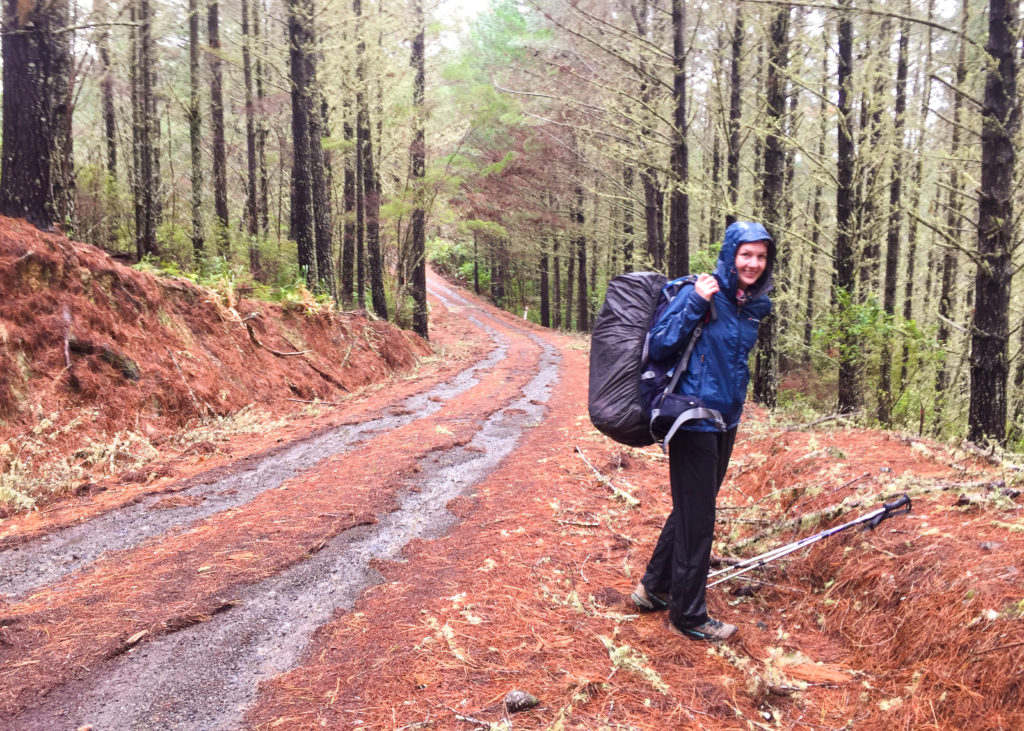
The road undulated for the majority of the 15 kilometres through to Paihia. There were very steep hills followed by short steep downhill sections. At each junction we had to check the map to make sure we were going the right way, as the trail was not particularly well signposted.
It started to drag on and on, but at least the rain had eased. About half way along my feet really started to ache again. Shortly after, I noticed that my knee was also aching again. I could feel myself walking slightly differently to compensate for it.
 A rather suspect looking ‘water source’ along the way on the Waitangi Forest Track.
A rather suspect looking ‘water source’ along the way on the Waitangi Forest Track.
Along the way, we passed a very important landmark for Te Araroa. The Kerikeri to Waitangi section of the trail was the very first official section of the TA to be opened way back in 1995, and there is a commemorative stone marking the occasion in the Waitangi Forest. Unfortunately, by the time we reached the junction, both of us were exhausted, and the thought of hiking a short distance off trail was far from our minds. So instead, we hiked on past without visiting the site.
The last hour or two of the forest walk were very difficult. I had this idea in my head that once we reached Waitangi we would be only a stone’s throw away from the finish line in Paihia. But when we finally emerged at the end of the forest road there was still a good 6 kilometres or more of more road walking to get out of the forest, then a little further along by a golf course and past the Waitangi treaty grounds.
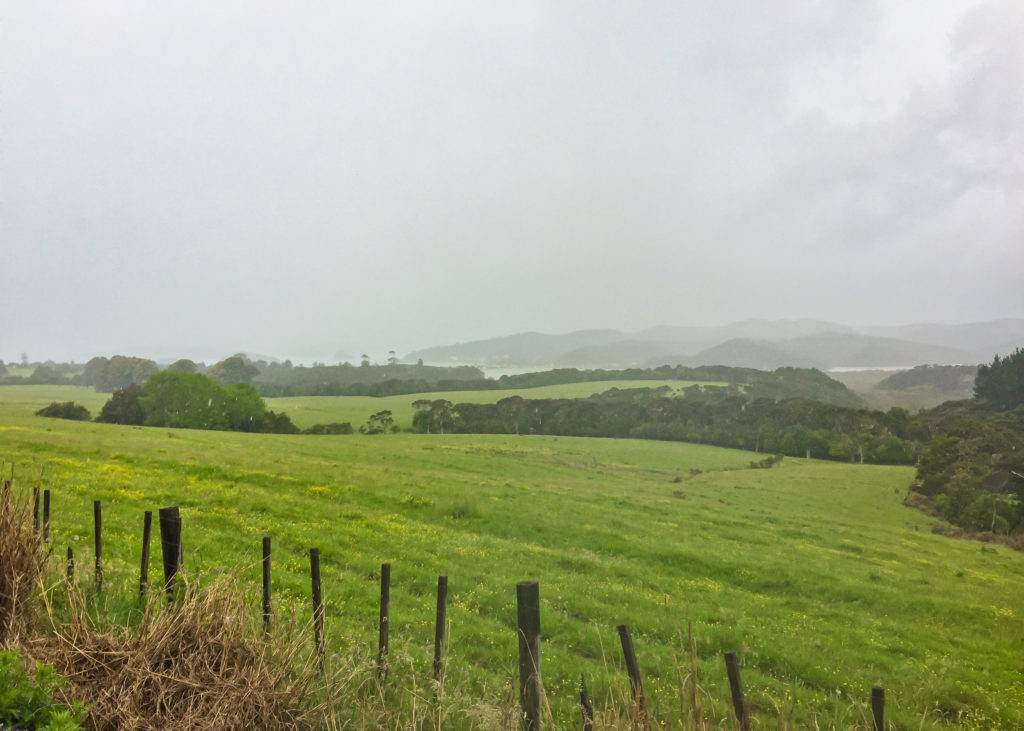 Emerging out of Waitangi Forest onto a road walk section into Waitangi.
Emerging out of Waitangi Forest onto a road walk section into Waitangi.
 Our first horses of the trail. We caught sight of a large cruise ship in the distance from this viewpoint also.
Our first horses of the trail. We caught sight of a large cruise ship in the distance from this viewpoint also.
I had the pleasure of visiting the Waitangi treaty grounds a few years ago with my family. I can honestly say that it was a place that really resonated with me, despite the fact that I am not a born and bred kiwi.
For those who don’t know, back in 1840 the Maori inhabitants of New Zealand came together with the British or Pakeha settlers to sign a document called the Treaty of Waitangi. Te Tiriti, as it is now known, is the closest New Zealand comes to having a constitution, and sets out the basic rights and protections of Maori subjects under British rule. Unfortunately the Treaty also serves as the instrument by which Maori ceded governance to the Crown, albeit still recognising their ability to govern their own lands.
It has been a source of much vitriol in the recent past. Since the early 1990s legislation in New Zealand has been passed allowing the creation of a ‘Waitangi Tribunal’ and a claims process in which iwi (tribes) can apply to be compensated for land which was taken from them during the colonisation period (among other means of redress). The Waitangi Tribunal claims continue to this day, with increasingly polarised opinions on the subject.
I’d highly recommend taking the time to visit the Waitangi Treaty Grounds on your way past. For a small fee (currently NZD$50 for international adults and NZD$25 for NZ residents) you not only get access to the place where the Treaty was signed, but also a glimpse into the history of this young country.
In fact, the entire region from Waitangi to Paihia to Russell on the opposite side of the bay is filled with history. Russell, or Kororareka as it was known in the 1840s, was the first permanent European settlement in New Zealand. It’s easily accessible by a short water taxi from Paihia (another recommended excursion). Rusell developed into one of the most prosperous trading ports in the Pacific, but the difficult relationship between Maori and European settlers became strained. Before long the lack of law enforcement led to it becoming known as the “Hell Hole of the Pacific.”
Christ Church in Russell is the oldest church in New Zealand (1836), and is well worth a visit, if not only to take a peek at the musket ball holes which line its walls. These holes are the consequence of one particularly nasty altercation during the Battle of Kororareka in 1845.
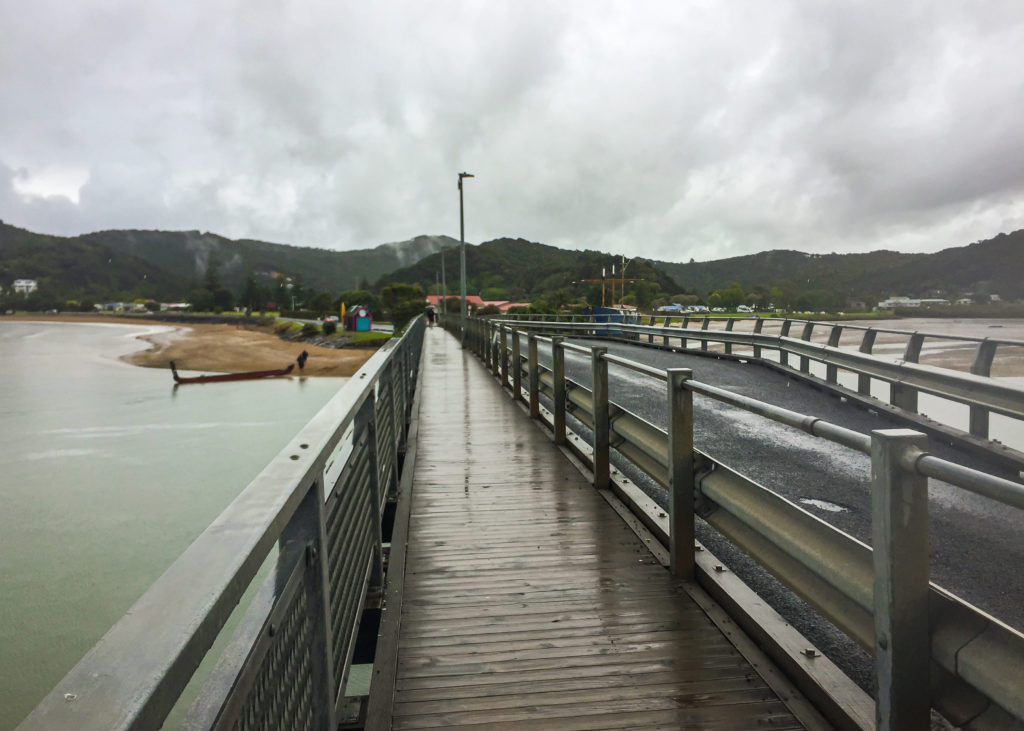 Walking over the one-way bridge that separates Waitangi from Paihia.
Walking over the one-way bridge that separates Waitangi from Paihia.
After passing over the Waitangi Bridge we walked along the main road into Paihia. I particularly noticed a couple of waka (Maori war canoes) practicing in the small inlet, I assumed for a celebration of some kind, or perhaps even the upcoming Treaty remembrance in early February.
 Taking a look out towards the main sweep of Te Ti Bay from the Waitangi Bridge, including a Maori waka pulled up on shore in the middle right.
Taking a look out towards the main sweep of Te Ti Bay from the Waitangi Bridge, including a Maori waka pulled up on shore in the middle right.
By the time we reached the iSite in Paihia I was really ready for a toilet stop! We stopped to watch a small sightseeing helicopter take off and then scoured Booking.com for somewhere to stay. After the day we’d had, we decided it might be nice to get a private motel room for the evening and take the opportunity for a bit more luxury, peace and quiet.
We turned up at the Bounty Inn just before 4pm, and booked ourselves into a twin room. It was a good size room, with a king bed and a single bed.
Priorities. First: Agree who gets the big bed. Luckily this swung in my favour.
Second: Get clean. The bathroom in our suite was exquisite, with a beautiful flushing toilet and a powerful modern shower.
Third: Dry wet gear. After showering we decanted our packs and began to hang our wet gear all around the room and on the verandah. It had really started to pour with rain the closer we got to Waitangi, so our gear was saturated by the time we arrived.
 Our room in the Bounty Inn, Paihia after our packs exploded.
Our room in the Bounty Inn, Paihia after our packs exploded.
Finally: Do laundry. Even though I’d only done a load of washing back in Kaitaia a few days ago, I was mindful that I wouldn’t have the opportunity to do any more for a few days.
As time passed, I noticed that my knee was getting more and more stiff. It was very uncomfortable to walk on and I was starting to get worried. We agreed we’d go to the pharmacy to pick up some supplies (specifically some voltaren to help loosen my knee and some smaller strapping tape for my toes) and then get something to eat. We also needed to pick up some supplies at the supermarket for the section ahead.
We looked at the maps and the trail notes. I became quite anxious when I realised how many big days were coming up. Tomorrow would be a 27km day to Sheryl’s place at Waikare, followed by roughly 26km the following day through Russell forest to Oakura (if I can make it that far), and then finally 34km the next day to Whananaki Holiday Park.
I explored the option of splitting day 2 or 3 in half, to ease my knee back into it. But there were very few options for places to stay in between that would make it feasible. Also, Julia wanted to make it to Whananaki in 3 days so we could be in Ngunguru in 4 days’ time.
I didn’t feel ready to walk by myself for long stretches (especially through dense forest), but also I knew that Julia’s pace was not doing me many favours either. Almost all the days on trail thus far had been much harder than I was expecting. If the walking eased up a bit, then I thought I could probably make it in the planned itinerary. But even the Russell forest alone was 18km and could take up to 8 hours to get through!
The thought crossed my mind that at the moment, I was struggling to hike for more than 5 hours per day.
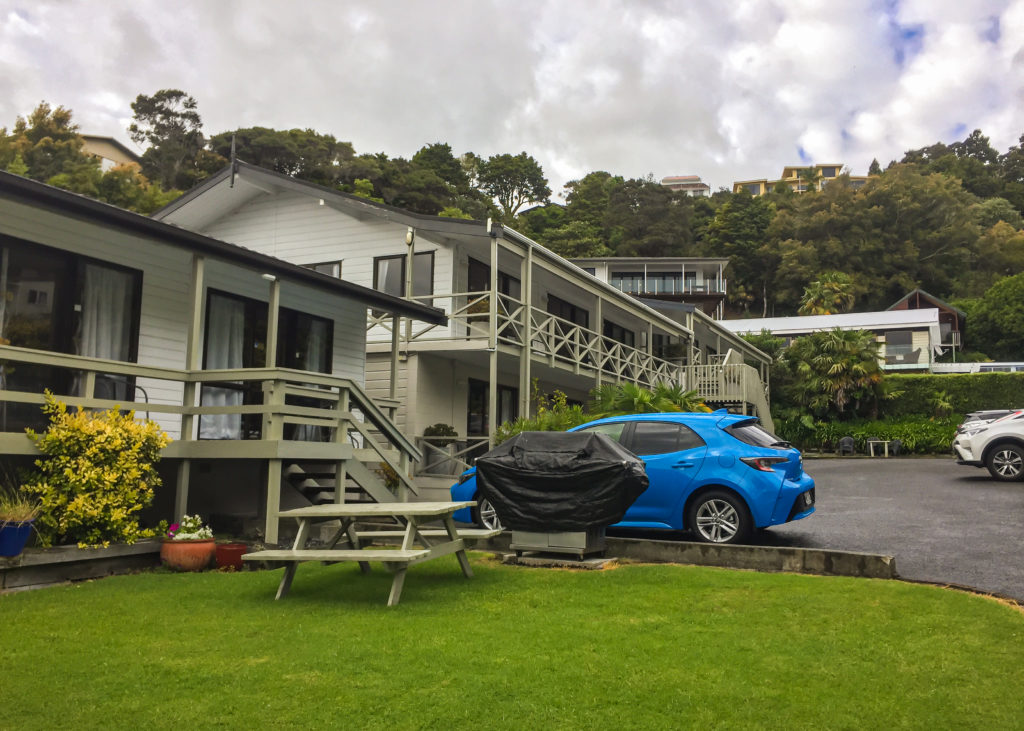 Bounty Motel, Paihia. Our haven for the evening.
Bounty Motel, Paihia. Our haven for the evening.
Eventually, I decided to just take it one day at a time (this soon became a mantra for the rest of the trail). Things would happen as they were meant to happen, and if I needed to get off trail for any reason, I would find a way.
After we’d picked up the supplies we needed we decided to get Indian at Delhi 6 just above Four Square for dinner. The $22 meal was rather average, but it at least filled a hole.
Following dinner we visited the Four Square to get our supplies for the next days. I was surprised to see that they were a really hiker friendly store. They had plenty of supplies in smaller varieties, including mini bier sticks, small jars of jam and single serving packets of peanut butter. I bought some cheese triangles and the aforementioned peanut butter sachets.
Unfortunately (as is often the case in New Zealand) I couldn’t get everything I wanted from Four Square, so a quick trip to Countdown just down the road filled in the gaps: rice crackers and (most importantly) chocolate for dessert.
Back at the motel, I telephoned Mum. We talked about my knee for quite a while and she gave me some good suggestions for how I might be able to manage the next few days (after speaking to one of the doctors at the medical centre where she works).
I spent the rest of the evening with my knee up on a pillow, drinking tea and watching TV. I knew it was probably a dangerous habit to get into, but I was really enjoying having all the comforts of home again.
To my surprise, Ben Fogle’s series with Miriam Lancewood and Peter Raine was on TV. I had first heard of them almost a year ago, when their story of living off-grid in the NZ backcountry wilderness for a year piqued my interest. We watched the whole episode, talking about whether we thought that kind of lifestyle would suit us or not and comparing it to our current adventure.
Before long it was time for bed. I settled down for the evening on the comfortable mattress, feeling pleasantly satiated but at the same time restless. Time would tell whether my knee would hold up, or if perhaps the situation would lead to an early exit from Te Araroa for me…
prefer to watch?
Watch the full video from this section of Te Araroa below.
